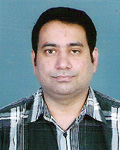Introduction
Diabetes mellitus, particularly type II, is a major public health concern worldwide1. According to WHO, there will be an alarming increase in the population with type II diabetes mellitus, both in the developed and developing countries over the next two decades. In the developed world, the estimated increase is approximately 46%, from 55 million in 2000 to 83 million in 2030; whereas, among developing nations, the estimated increase is approximately 150%, from 30 million in 2000, to 80 million in 20301.
Studies such as the Wisconsin Epidemiological Study have proved that microvascular complications such as diabetic retinopathy (DR) in the diabetic population are linked to the duration of the disease2. While the occurrence of DR cannot be prevented, its sight-threatening complications can be minimized. Previous research has shown that 63% of the rural diabetic population have not had an eye examination3. Similarly, the non-response to the invitation to attend DR screening camps was such that of 1076 people who were diagnosed as having diabetes in the diabetes-detection screening camps, only 125 (11.6%) attended the DR screening camps, conducted just one week later4.
Dandona et al5 also observed a low level (28.8%) of awareness about DR among an urban general population in India; and increased awareness of DR was found in individuals belonging to upper and middle socio-economic strata. The present study was undertaken to assess the awareness level or knowledge of diabetes and DR in a rural Indian population, and its association with their attitude and practice.
Materials and Methods
The detailed research methodology of our DR screening model in rural population is described elsewhere6. During these camps, we conducted 145 awareness meetings on diabetes and DR in the five contiguous southern Indian rural districts of Tamil Nadu (Kanchipuram, Vellore, Thiruvannamalai, Villupuram and Thiruvallur), India (Fig1).
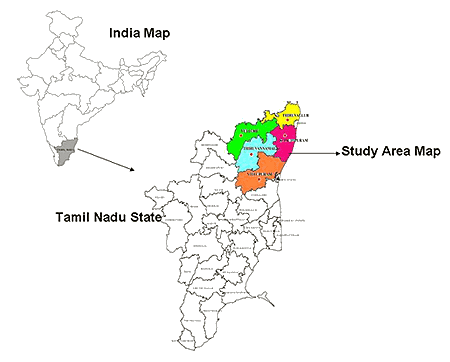
Figure 1: Map of the study area in rural southern India.
Awareness methodology
Relevant strategy was used to create a targeted level of awareness of diabetes and DR. Awareness meetings were conducted at least one month prior to the screening camps in the study areas. The meetings were targeted at various population groups such as school children, youth, NGO/agencies such as self-help women's groups, Lions, Rotary etc.
Leaflets, banners, digital display monitors (in railway stations and post offices) and lamp post kiosks (a cylindrical structure on which awareness messages on card boards were displayed), wall paintings, stickers on city buses, posters, and audiovisual CDs containing information on diabetes and DR in the regional language Tamil were prepared. During the project period, special occasions like World Diabetes Day were celebrated with measures such as meetings, rallies and quizzes to create awareness.
Knowledge, Attitude and Practice study methodology
A detailed search in literature on guidelines for conducting a Knowledge, Attitude and Practice (KAP) study was carried out; and KAP questionnaires on DR in published reports for a general population were collected7-9. Based on this literature, a KAP questionnaire was prepared in English and the local language Tamil to suit the target population. Social workers were trained in administering the questionnaire, and were also tested for reliability in administering the questionnaire. The questionnaire was pre-tested in a sample group of a representative population. The responses were analyzed as to whether the questions were understood or not, and necessary modifications were incorporated in the questionnaire. Participants were given the questionnaire prior to the awareness meetings. Instructions for filling in the questionnaire were read out by the social workers.
Sampling method and sample size
Of the 28 347 individuals who attended awareness meetings, a systematic random sampling strategy was used, and data were collected from every 14th subject. In all, data were available for 1938 individuals.
Data collection
The basic data recorded included age, gender, language spoken at home, religion, education level and family income. Socioeconomic status was determined on monthly per capita income in Indian rupees: extreme lower, ≤ 200; lower, 201-500; middle, 501-2000; and upper, >20009.
The questions that evaluated knowledge included:
- Have you heard of diabetes mellitus or diabetic retinopathy?
- Is diabetes mellitus a hereditary disease?
- Does diabetic retinopathy affect vision?
- Can individuals with controlled diabetes have eye problems?
- What eye problems can individuals with diabetes have?
Attitude was assessed by asking: should subjects with diabetes go for eye examinations? The responses to the question, 'Does good control of blood sugar result in preventing a visit to an ophthalmologist?', indicated the practice pattern. Other questions elicited responses about the type of healthcare professional they visit for eye ailments, and currently available methods to treat DR. The responses to questions regarding their knowledge and attitude towards diabetes and DR were acquired in the format of 'yes', 'no' and 'do not know'.
Definitions
Knowledge group for diabetes: This group contained population that responded 'yes' to both questions: (i) Have you heard of diabetes mellitus? and (ii) Is diabetes a hereditary disease?
Knowledge group for DR: This group contained population that responded 'yes' to both these questions: 1. Have you heard of diabetic retinopathy? 2. Does diabetes affect vision?
Statistical analysis
Statistical analysis was performed with the SPSS v 13 (SPSS Inc; Chicago, IL, USA). Determinants of knowledge on diabetes and DR such as age, gender, language, literacy, religion and socioeconomic status were analyzed between the groups using univariate analysis followed by multiple logistic regression analysis. The association of knowledge of DR with attitude and practices was evaluated between the groups using univariate analysis (Chi-squared test). A two-tailed 'P' value of less than 0.05 was considered statistically significant; 95% confidence intervals (CI) of the estimates were calculated by assuming normal approximation of binomial distribution for prevalence of 1% or more and Poisson distribution for prevalence less than 1%. This method of analysis is similar to other KAP studies in eye health and, thus, enables comparison among the studies5.
Results
A total of 1938 individuals in rural areas were interviewed for KAP study on diabetes and diabetic retinopathy. All patients were above the age of 15 years (mean age, 29±13 years; median, 25 years; range, 15-77 years). Women were 60.8% of the population.
Table 1 shows factors influencing knowledge of diabetes mellitus and DR. Knowledge about diabetes mellitus was noted in 966 individuals (49.9%), and about DR, in 718 individuals (37.1%). Multiple logistic regression analysis indicated that knowledge of diabetes was significantly higher among women compared with men (OR=1.93; 95% CI: 1.55-2.39), Christians compared with Hindus (OR=1.48; 95% CI: 1.07-2.04) and in those with upper socioeconomic status compared with extreme lower socio-economic status (OR=2.60; 95% CI: 1.84-3.67). Knowledge of DR was significantly higher among subjects speaking the Malayalam language, compared with those speaking the Tamil language (OR=3.80; 95% CI: 2.03-7.13), Christians compared with Hindus (OR=1.73; 95% CI: 1.27-2.35), and in those of upper socioeconomic status, compared with extreme lower socio-economic status (OR=1.85; 95% CI: 1.32-2.58).
Table 1: Factors influencing knowledge of diabetes mellitus and diabetic retinopathy
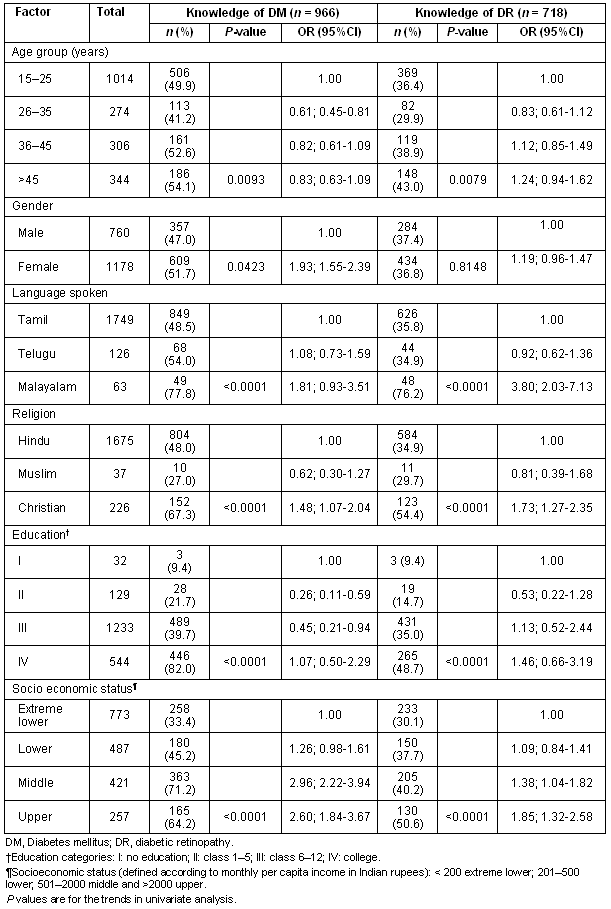
A subgroup analysis of literacy levels was performed for subjects who spoke the Malayalam language and those belonging to the Christian faith in the knowledge group for DR. Among the 47 subjects who spoke Malayalam in the knowledge group for DR, 33 (70.2%) had college education and 14 (29.8%) had school education; none was illiterate. Likewise, among 123 subjects who belonged to the Christian faith in the knowledge group for DR, 52 (42.3%) had college education, 69 (56.1%) had school education, and only 2 (1.6%) were illiterate.
Table 2 describes the attitude and practice patterns between the knowledge and no-knowledge groups. It shows that a higher percentage (93.3%, p<0.0001) of individuals having knowledge about DR felt that a person with diabetes needs to go for regular eye examination (showing correct attitude) compared with the no-knowledge group of DR. Of individuals who did not have knowledge about diabetic retinopathy, a higher percentage (55.5% p<0.0001) felt that if they kept their blood sugar under control they could avoid visiting an ophthalmologist (showing poor practice pattern).
Table 2: Association of knowledge of diabetic retinopathy on attitude and practice
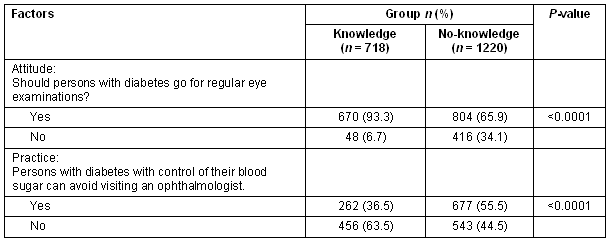
Table 3 shows that individuals with knowledge about DR knew more about various treatment options to treat DR: good control of diabetes (53.2%), laser treatment (50.1%) and surgery (38.2%); whereas, the no-knowledge group subjects knew about available treatments for DR in lesser proportions, that is laser treatment (22.1%), good control of diabetes (34.1%) and surgery (18.4%).
Table 4 shows that the knowledge group (for diabetic retinopathy) predominantly goes to an ophthalmologist (82.6%), less often to an optometrist (48.3%) and a non-ophthalmologist (39.6%). Individuals in the no-knowledge group showed a different pattern of preference for visiting an ophthalmologist (69.6%), an optometrist (41.1%) and a non-ophthalmologist (33.4%) in the event of eye problem.
Table 3: Knowledge of available treatment for diabetic retinopathy
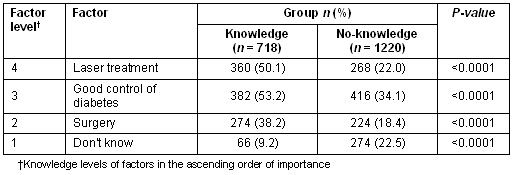
Table 4: Choice of healthcare professional in the event of eye problem

Discussion
Patients with type II diabetes mellitus at the time of initial diagnosis must undergo a dilated fundus examination to rule out evidence of diabetic retinopathy10. The results of this study suggested that only half of the screened population were aware of the disease, diabetes mellitus, and just 37% had knowledge about its eye complication, DR.
More individuals in the older age group (40-49 years), those who spoke Malayalam, who followed the Christian faith, and who had a high socioeconomic status all had better knowledge of diabetes and retinopathy. Literacy and its impact on increased awareness or knowledge of diseases was a known fact in earlier studies11,12 Malayalam is a regional language spoken in Kerala, the southernmost state of India with the highest level of literacy13. This further supports the proposition that education is important in creating awareness.
Although not statistically significant due to low numbers, a trend was observed towards higher levels of literacy among Christian participants of the present study. This is consistent with national data showing literacy among the Christian population as being high (80.3%, compared with the national average of 64.8%)13.
Knowledge of diabetes, but not of DR, was more common among women. These findings are attributed to the presence of powerful self-help women's groups in rural Tamil Nadu14. This information is of importance because most of the rural females were housewives. As one of the nodal points in awareness campaigns they would influence other family members.
Dandona et al5 also reported increased awareness about the possibility of diabetes causing impaired vision among subjects aged older than 30 years, among those with any level of education and among those belonging to upper and middle socioeconomic strata; however, they reported results in urban population of India. To the best of our knowledge, a KAP study of this nature in a rural general population has not been reported previously.
Another major finding of our study was the impact of knowledge of DR on attitude and practice. Comparison between the group with knowledge and the group with no knowledge revealed statistically significant differences in terms of adopting the correct attitude and practices related to DR. Overall, over 90% of individuals were aware of the importance of regular eye examinations, but approximately one-third were under the impression that control of blood sugar is enough to avoid visiting an ophthalmologist.
Despite having knowledge about DR, only half of the population studied knew about the effect of good control of diabetes on DR, and about the availability of laser treatment to treat DR. Surgery, as one of the options to treat complications of DR, was not known to approximately 60% of the study subjects. This showed some lacunae in their knowledge and the need for more aggressive awareness campaigns on this subject. Interestingly, those with knowledge of diabetes preferred to go to an ophthalmologist in the event of any eye problem.
Namperumalsamy et al15 found very low levels of awareness among non-medical persons in south India. We found similar trends of low awareness in KAP study of GPs16. While several advances have taken place in the treatment of DR, little has been done to initiate any mass awareness program on diabetes and its microvascular complications such as DR.
Recommended awareness strategies
Awareness methodology specific for rural populations needs to be adopted6. Spreading knowledge of diabetes and related complications will motivate individuals with diabetes to visit ophthalmologists. This is an important step in preventing diabetes-related blindness.
Our study suggests that literacy, language and religion are interdependent factors associated with knowledge of diabetes and diabetic retinopathy. One useful approach may be to initiate literacy campaigns with a focus on creating awareness of health-related topics for rural populations.
Acknowledgements
The authors would like to acknowledge the Lions Club International Foundation and RD Tata Trust Mumbai for providing grants to the project.
References
1. Wild S, Roglic G, Green A, Sicree R, King H. Global prevalence of diabetes: estimates for the year 2000 and projections for 2030. Diabetes Care 2004; 27: 1047-1053.
2. Klein R, Klein B, Moss S. The Wisconsin Epidemiological Study of Diabetic Retinopathy: a review. Diabetes and Metabolic Review 1989; 5: 5559-5570.
3. Padmaja KR, Rajiv R, Pradeep GP, Swati A, Kumaramanickavel G, Sharma T. Use of eye care services by people with diabetes - South India experience. British Journal of Ophtahlmology. (Online) 2005. Available: http://bjo.bmj.com/cgi/eletters/82/4/410 (Accessed 10 May 2008).
4. Agarwal S, Mahajan S, Rani PK, Raman R, Paul PG, Kumaramanickavel G et al. How high is the non-response rate of patients referred for eye examination from diabetic screening camps? Ophthalmic Epidemiology 2005; 12(6): 393-394.
5. Dandona R, Dandona L, John RK, McCarty CA, Rao GN. Awareness of eye diseases in an urban population in southern India. Bulletin of the World Health Organisation 2001; 79(2): 96-102.
6. Rani PK, Raman R, Agarwal S, Paul PG, Uthra S, Margabandhu G et al. Diabetic retinopathy screening model for rural population: awareness and screening methodology. Rural and Remote Health 5(4): 350. (Online) 2005. Available: www.rrh.org.au (Accessed 8 July 2008).
7. Vision 2020. KAP study protocol. (Online) no date. Available: http://laico.org/v2020resource/files/KAPStudyMethodology.pdf (Accessed 24 March 2008).
8. Schmid KL, Schmid LM, Pedersen C. Knowledge of the ocular effects of diabetes among the general population of Australia and the members of Diabetes Australia. Clinical and Experimental Optometry 2003; 86(2): 91-103.
9. Dandona R, Dandona L, Naduvilath TJ, Nanda A, McCarty CA. Design of a population-based study of visual impairment in India: The Andhra Pradesh Eye Disease Study. Indian Journal of Ophthalmology 1997; 45: 251-257.
10. Early Treatment Diabetic Retinopathy Study Research Group. Early photocoagulation for diabetic retinopathy, ETDRS report no. 9. Ophthalmology 1991; 98: 766-785.
11. Williams MV, Baker DW, Parker RM, Nurss JR. Relationship of functional health literacy to patients' knowledge of their chronic disease. A study of patients with hypertension and diabetes. Archives of Internal Medicine 1998; 158: 166-172.
12. Rothman RL, Malone R, Bryant B. The spoken knowledge in low literacy in diabetes scale. The Diabetes Educator 2005; 31: 215-224.
13. Government of India. State of Literacy, Census of India, 2001. New Delhi: Government of India, 2001.
14. Horst R. Reapers, solitary no longer - NGO Watch - Tamil Nadu Women's Development Project. UN Chronicle (Online) 2002. Available: http://findarticles.com/p/articles/mi_m1309/is_2_39/ai_91088435 (Accessed 9 July 2008).
15. Namperumalsamy P, Kim R, Kaliaperumal K, Sekar A, Karthika A, Nirmalan PK. A pilot study on awareness of diabetic retinopathy among non-medical persons in South India. The challenge for eye care programmes in the region. Indian Journal of Ophthalmology 2004; 52: 247-251.
16. Rajiv R, Pradeep GP, Padmajakumari R, Tarun S. Knowledge and attitude of general practitioners towards diabetic retinopathy practice in South India. Community Eye Health Journal 2006; 19: 13-14.

